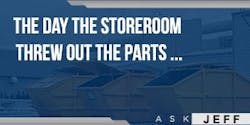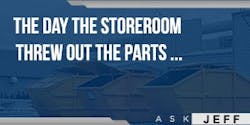Barry, storeroom clerk, Mobile, AL
Answer: Barry, “carrying costs” are the costs of maintaining storeroom inventory. Depending on the company and the storeroom's geographic allocation, these costs may include:
- building space
- building utilities
- insurance on stocked items
- interest if capital is borrowed to by the part
- labor to receive, store, cycle count, etc.
- taxes depending on the state
So, what does this mean to you and organization? Glad you asked. Often if a technician needs one part, he or she will order two or three of the item to have on hand just in case. Because it’s not a stock item, we add it to stock, believing that because we used it once, we are likely to need it again. The storeroom clerk talks to the vendor, who offers a 20% discount for buying five. The storeroom clerk, also thinking that if we need the part now, surely we'll need it again later, buys five. At this point, we have taken the business’s money (potentially borrowed money we will pay interest on) and tied it up with four parts on the storeroom shelf. Remember, the technician needed only one. It turns out that we just use one of those SKUs (stock keeping units) every five years. So, doing the math, we now have 20 years' worth of supply on the shelf. The piece of equipment where the part is used may not even be there in 10 years.
Here is where carrying costs come into play. Every three to five years, we will pay for those same parts again in carrying costs while they are sitting on the shelf. Now to compound matters, let’s assume that those items have a shelf life of five years before the rubber components stiffen and become unusable. Maybe we can use one over the next five years, so we end up trashing only three of the original five.
These are primary reasons that most proactive organizations work to reduce their amount of inventory value and drive increased turns with their MRO storeroom inventories. Ideally, we'll try to reduce down to storing only critical spares through the use of vendor partnerships and smart stocking strategies.
Talk soon,
Jeff Shiver, CMRP
If you have problems in the fields of maintenance, reliability, planning and scheduling, MRO storerooms, or leadership as examples, please contact Jeff Shiver with your question(s) here.
About the Author
Jeff Shiver
Founder and managing principal at People and Processes, Inc.
Jeff Shiver CMRP is a founder and managing principal at People and Processes, Inc. Jeff guides people to achieve success in maintenance and reliability practices using common sense approaches. Visit his website www.PeopleandProcesses.com, and contact him on LinkedIn at www.linkedin.com/in/jeffshiver or via email at [email protected].


